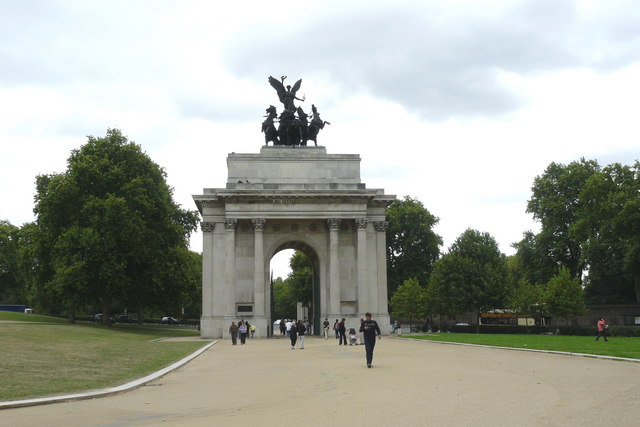
The area around London’s Hyde Park Corner is of great
interest to anyone who admires the memory of one of Britain’s greatest ever
generals, namely Arthur Wellesley, the 1st Duke of Wellington
(1769-1852), who was the hero of the Battle of Waterloo.
For one thing, this is where you will find the Duke’s London
home, Apsley House, which once had the iconic address “No 1, London” because it
was the first house inside the turnpike gate at Hyde Park Corner, which is
traditionally the point from which all distances to London from everywhere else
in the country are measured.
Apsley House, now under the care of English Heritage, is
open to visitors and contains many paintings and other items that were formerly
owned by the Duke of Wellington.
Opposite the front of Apsley House is a small green area,
surrounded by a busy traffic circulatory system, on which are several memorials
and monuments of military significance.
Wellington Arch
The most notable of these is the massive Wellington Arch –
not to be confused with Marble Arch which is at the northeast corner of Hyde
Park as opposed to the southeast. It was built in 1826-30 to a design by
Decimus Burton and was originally sited as the western entrance to Constitution
Hill, which runs from Hyde Park to one side of Buckingham Palace. However, it
was moved a short distance to its present position in 1882-3, although it is
still in alignment with the course of Constitution Hill. The Arch is also known
as Constitution Arch.
The Arch originally had a large equestrian statue of
Wellington on top, but this was moved to Aldershot early in 1887 to eventually be
replaced by a statue by Adrian Jones entitled “Peace in her Quadriga”, which
was cast in 1912 and remains Europe’s largest bronze statue.
The Arch contains rooms on either side and across the top,
and these are open to the public, who can view an exhibition about London’s
statues. From the 1950s until 1992 these rooms comprised London’s smallest
police station, providing a base for two sergeants, 10 constables and a cat!
Wellington Memorial
Directly opposite Apsley House, and therefore at an angle to
Wellington Arch, is the monument that took the place of the one that was
removed from the top of the Arch. This is a bronze, by J E Boehm, of Wellington
astride Copenhagen, his favourite warhorse. It was erected in 1888.
Copenhagen was certainly a remarkable horse, having been
Wellington’s mount at the Battle of Waterloo for more than 16 hours all told.
The story goes that, after the battle, Wellington dismounted in the stable
block and Copenhagen, relieved to be off duty at last, lashed out with such
fury in his master’s direction that, had he connected, Wellington would have
joined Nelson as a great military victor cut down in the hour of his triumph.
The Memorial statue stands on a stone plinth that is
“guarded” by the figures of four soldiers who are representatives of troops at
the Battle of Waterloo. These are a Grenadier, a Welch Fusilier, an
Inniskilling Dragoon and a Royal Highlander. These figures were cast from 12
French cannons that were captured during Wallington’s campaigns.
The Statue of Achilles
On the other side of Apsley House, just inside Hyde Park, is
a somewhat curious memorial to the Duke of Wellington, namely a huge bronze
figure that purports to be Achilles.
This was the “Ladies’ Trophy”, so called because it was paid
for by subscriptions from the women of Britain as their tribute to the Duke. It
was modelled by Sir Richard Westmacott and erected in 1822.
One problem with the statue is that it has nothing to do
with either the Duke of Wellington or Achilles. It is actually a copy of a statue
of a horse-tamer, with sword and shield, in Rome. However, the main reason why
it raised plenty of eyebrows in 1822 is that the warrior depicted is almost
entirely naked without even the benefit of a fig-leaf! The question has often
been raised about how much the ladies who commissioned the statue knew about
what they were going to get!
© John Welford
No comments:
Post a Comment